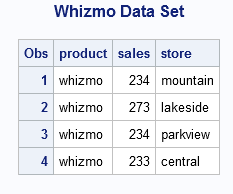WHERE= Data Set Option
Specifies specific conditions to use to select observations from a SAS data set.
| Valid in: | DATA step and PROC steps |
| Category: | Observation Control |
| Restriction: | Cannot be used with the POINT= option in the SET and MODIFY statements. |
Syntax
Syntax Description
where-expression
is an arithmetic or logical expression that consists of a sequence of operators, operands, and SAS functions. An operand is a variable, a SAS function, or a constant. An operator is a symbol that requests a comparison, logical operation, or arithmetic calculation. The expression must be enclosed in parentheses.
logical-operator
can be AND, AND NOT, OR, or OR NOT.
Details
-
Use the WHERE= data set option with an input data set to select observations that meet the condition that is specified in the WHERE expression. SAS brings the observations into the DATA or PROC step for processing. Selecting observations that meet the conditions of the WHERE expression is the first operation SAS performs in each iteration of the DATA step.You can also select observations that are written to an output data set. In general, selecting observations at the point of input is more efficient than selecting them at the point of output. However, there are some cases when selecting observations at the point of input is not practical or not possible.
-
You can apply OBS= and FIRSTOBS= processing to WHERE processing. For more information see Processing a Segment of Data That Is Conditionally Selected in SAS Language Reference: Concepts.
-
You cannot use the WHERE= data set option with the POINT= option in the SET and MODIFY statements.
-
You can use both the WHERE= data set option and the WHERE statement in the same DATA step. SAS ignores the WHERE statement for data sets with the WHERE= data set option. However, you can use the WHERE= data set option with the WHERE command in SAS/FSP software.
Note: Using indexed SAS data sets
can improve performance significantly when you are using WHERE expressions
to access a subset of the observations in a SAS data set. See Understanding SAS Indexes in SAS Language Reference: Concepts for a complete discussion of WHERE
expression processing with indexed data sets and a list of guidelines
to consider before indexing your SAS data sets.
Comparisons
-
The WHERE statement applies to all input data sets, whereas the WHERE= data set option selects observations only from the data set for which it is specified.
-
The DROP= and KEEP= data set options select variables for processing, whereas the WHERE= data set option selects observations.
Examples
Example 1: Selecting Observations from an Input Data Set
This example uses the
WHERE= data set option to subset the SALES data set as it is read
into another data set:
data whizmo; set sales(where=(product='whizmo')); run;
Input Data Set Observations

Example 2: Selecting Observations from an Output Data Set
This example uses the
WHERE= data set option to subset the SALES output data set:
data whizmo(where=(product='whizmo')); set sales; run;
Output Data Set Observations

Copyright © SAS Institute Inc. All Rights Reserved.